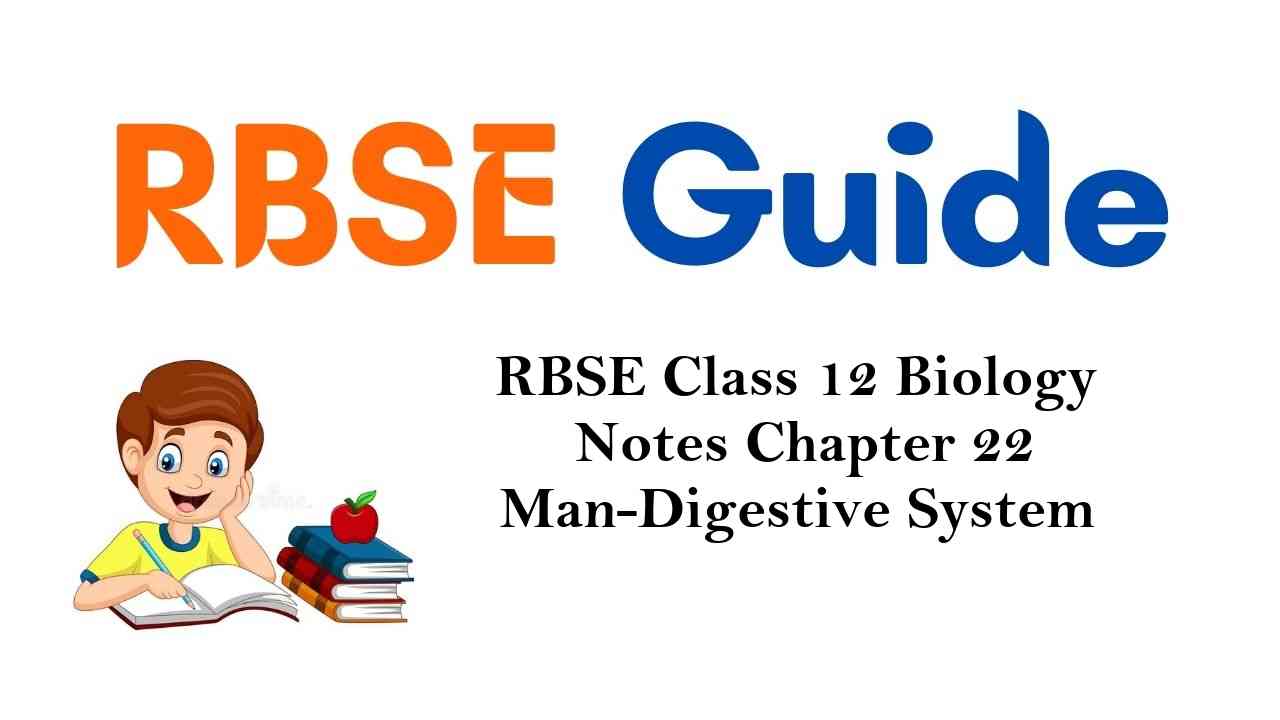Rajasthan Board RBSE Class 12 Biology Notes Chapter 22 Man-Digestive System
1. The organ system that converts complex food into their simpler form with the help of enzymes and absorbs the digested food is called as digestive system.
2. The digestive system includes alimentary canal and digestive glands.
Alimentary Canal
1. The alimentary canal is a simple tube between the mouth & the anus which exhibits many modification to perform different functions.
2. The alimentary canal originates from embryonic ectoderm & endoderm.
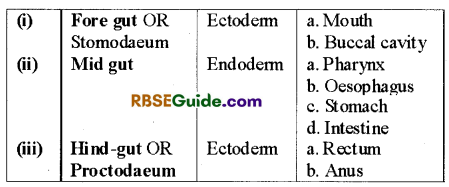
It’s length is about 9 meter.
Mouth and Buccal Cavity
1. It is a transverse slit-like structure.
2. The mouth is guarded by a pair of lips viz. upper lip and lower lip. The lips of the mammals are muscualr and movable.
3. The mouth opens into a buccal cavity.
4. It is a cavity in the head region. It’s dorsal side is made up of palate, the ventral side is made up of throat while both the lateral sides are made up of cheeks.
5. The ventral side of the buccal cavity is occupied by a flat and muscular tongue. The tongue bears taste buds which
are sensory to sour, salty, sweet and bitter tastes.
![]()
6. Human tongue bears three types of taste buds. viz.-
- Circumuallate
- Fungifom and
- Filliform
Foliate taste buds are absent in human beings.
Functions of the tongue
- It functions as gustoreceptor.
- It helps in the mastication of the food.
- It helps in the swallowing of the bolus.
- It acts as a brush to clean the teeth.
- In human beings, it helps in speech.
The buccal cavity has upper & lower jaws which are beset with teeth. The arrangement of the teeth on the jaws is called as dentition.
![]()
Salient Features of Teeth
i. The mammalian teeth are thecodont.
ii. The mammalian teeth are diphyodont i.e. there are two sets of the teeth in the life viz.
- Milk or Deciduous teeth-There number is 20.
- Permanent or Non-deciduous teeth : There number is 32.
iii. The mammalian teeth are heterodont i.e. 4 types of teeth are found viz.
- Incisors
- Canines
- Premolars
- Molars
Last four molars are called as wisdom teeth
Dental formula:
1. The dental formula denotes position, number & type of teeth in the jaws.
2. The dental formula denotes teeth in half of the jaws.
3. Total number of teeth can be obtained by doubling the dental formula.
4. Dental formula of Man-
- Infant ⇒ 12/2, C 1/1, Pm 0/0, M 2/2 ⇒ 10 x 2 ⇒ 20
- Adult ⇒ I 2/2, C 1/1, Pm 2/2, M 3/3 ⇒ 16 x ⇒ 32
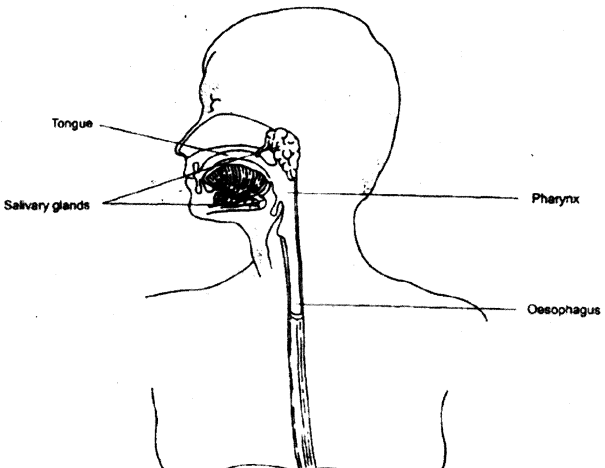
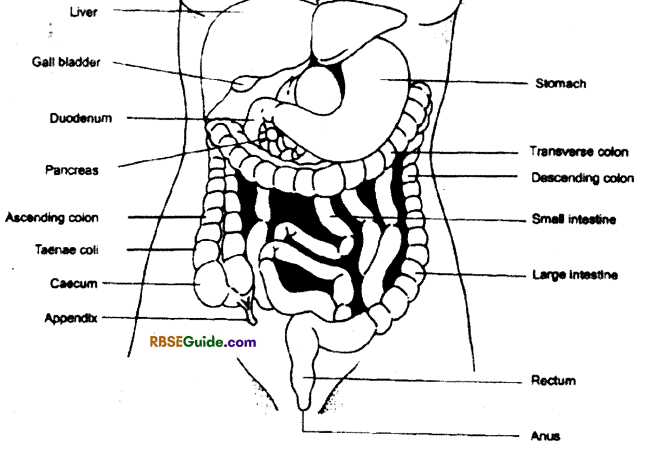
The tooth is ecto-mesodermal in origin and each tooth have three parts
![]()
(i) Crown
- It is the exposed part of the tooth which is chiesel-shaped in the incisors, pointed in the canines and broad & flat in the cheek teeth.
(ii) Neck
- It is the middle part of the tooth which is covered by the gums.
(iii) Root
- It remains embedded in the bony socket. The number of root in the incisors & canines is 1-1, in premolars is 2 and in molars is 3-5.
- The root is bounded by a peridontal membrane.
- The tooth is mainly made up of dentine. It is provided with canaliculi.
- The crown part of the tooth is covered by a hard substance, the enamel which is formed by ectodermal ameloblasts. It is the hardest substance in the body which consists of 95% inorganic substances (calcium phosphate, Mg, Na, K, hydroxy-peptide etc.) and 5% water.
- The root of the tooth is covered by a substance called cement, it is secreted by the cementocytes.
- Each tooth has a pulp cavity which is full of pulp. The pulp consists of connective tissues blood capallaries,
nerves & odontoblats. The pulp cavity open out through an apical pore which get closed lateron.
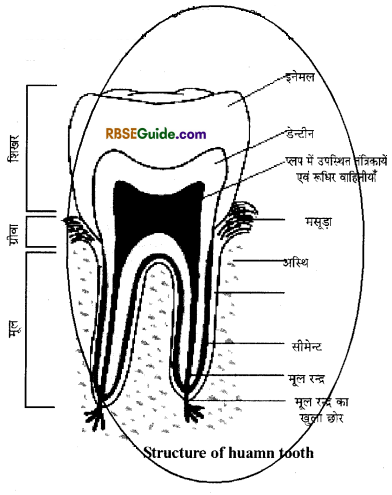
Oesophagus
- The oesophagus passes through the neck & thorax. It pierces through the diaphragm and finally opens into the stomach.
- It’s length depends upon the length of the neck. In man, it’s length is about 25 cm.
- Internally, it has many longitudinal folds.
- The anterior part of the oesophagus is made up of striated (Voluntary) muscles. Rest part is made up of smooth muscles.
![]()
The wall of Oesophagus consists of follower layers :
- Serosa : Outermost layer
- Musculature : It includes an outer layer of longitudinal muscles and inner layer of circular muscles.
- Submucosa : It is made up of connective tissues. It has blood vessels, nerves and tymph ducts.
- Mucosa : It is the innermost layer which is made up of stratified squamous epithelium.
Stomach
- It is a bag-like structure which is situated in the anterior left part of the abdominal cavity, just below the diaphram.
- Its anterior part is called as fundus, middle part as body and posterior part as plyoric.
- There is a cardiac sphinctor (valve) between the oesophagus & the stomach.
- Similarity, the basal opening of the stomach is regulated by a pyloric sphinctor.
- The main body forms 80% of the stomach and it secretes most of the part of the gastric juice.
Histology of Stomach
- The wall of the stomach consists of following layers from outside to inside
(i) Serosa
- It is modified visceral peritoneus which is made up of squamous epithelium.
(ii) Musculature
- It includes outer layer of longitudinal muscles and inner layer of circular muscles. There is an Aurabach plux in between the longitudinal and circular muscles.
- The stomach has an additional layer of oblique muscles.
![]()
(iii) Sub-mucosa
- It is the most developed layer which is made up of connective tissues. In addition, it includes blood vessels, nerves, tymph vessels & gland cells.
- There is a Meissner’s plux in the sub-mucosa.
(iv) Muscularis mucosa
- It is situated in the sub-mucosa.
- It consists of three layers viz. – outer layer of circular muscles, middle layer of longitudinal muscles & inner layer of circular muscles.
(v) Mucosa
- It is the inner most layer which is made up of columnar epithelium.
- It includes many Goblet cells to secrete mucous.
- It also contains oxyntic cells or parietal cells which secrete dilute HCl.
- It also bears zygmogen or peptic or chief cells which secrete gastric enzymes.
Intestine
- It is the longest part of the alimentary canal. It’s length in the rabbit is 4 to 5 metre and in human beings is 7 to 8 metre.
- The intestine is divisible into four parts viz.—duodenum, jejenum, ileum or small intestine & large intestine.
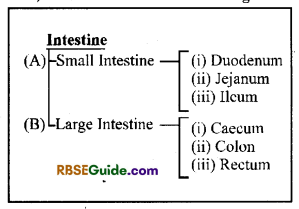
(A) Intestine-
- The pylorus part of the stomach opens into the intestine. It’s length is about 7.5 meter.
It consists of three parts :
(i) Duodenum
- It is the anterior most part of the intestine which is U- shaped & it is of 15 cm in length.
- The gall bladder gives out a bile duct which is also called as choledocus duct.
- There is a pancrease in between the limbs of the duodenum which is irregular in shape. The pancrease opens into the middle part of the duodenum through a pancreatic duct which is also called as Wirsung’s duct.
- In human beings, the bile duct & the pancreatic duct open into an ampulla of Vator which intum open into the proximal part of the duodenum. This opening is guarded by a sphinctor of Odi.
![]()
Histology of Duodenum.
The histology of duodenum is similar to the histology of the stomach except the following :
(a) The musculature of the duodenum lack oblique muscles.
(b) The sub-mucosa layer of the duodenum is provided with special Brunner’s glands which secrete mucous.
(c) The mucosa layer of the duodenum forms many crypts of Leiberkuhn. They have large number of argentaffin cells.
(ii) Jejanum : It is a middle and smaller part.
(iii) Ileum :
- It is the longest part of the intestine which is coiled. The coiled shape is maintained with the help of mesenteries.
- It’s musculature lack the oblique muscles and it’s submucosa is without Burner’s glands.
- It’s mucosa layer forms many Villi & Crypts of Leiberkuhn.
- The connective tissues in the villi are called as lamina propria which consists ofB.Vs, & lymph vessels.
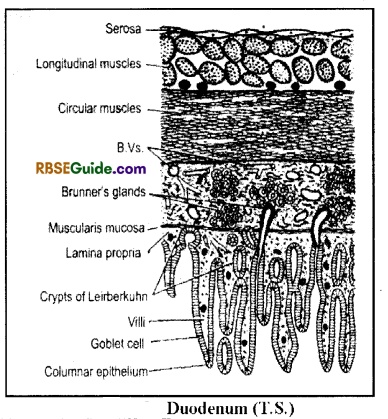
- There are Pever’s patces in the submucosa which are lymph nodes and form lymphocytes.
- It’s length is about 6.5 meter.
- The intestinal cavity has special longitudinal folds which are called as folds of Kackring.
- The mucosa of the ileum has special Paneth’s cells which secrete intestinal juice or succus entericus.
Large Intestine
- This pan of the intestine is shorter but it’s diameter is large.
- The large intestine includes caecum, colon and rectum
Caecum
- It is a special structure which is found in herbivorous animals to digest cellulose.
- In human beings, the caecum is found in the form of vestigeal vermiform appendix. It’s opening remains closed by a sphinctor. The ileo-caecal valve is also vestigeal which get incorporated into the wall. It contains lymph nodes which form lymphocytes.
Colon
1. It’s length is 1.5 to 2 metre in human beings.
2. Human colon has four parts
- Ascending colon.
- Transverse colon.
- Descending colon.
- Sigmoid colon.
It’s outer surface has a Longitudinal muscle band which is called as taenae coli.
![]()
Rectum
- It is the last part of the alimentary canal. It’s length is 1820 cm in human beings.
- The terminal part of the recutm is called as anal canal which leads outside through the Both the anal canal and anus are ectodermal in origin.
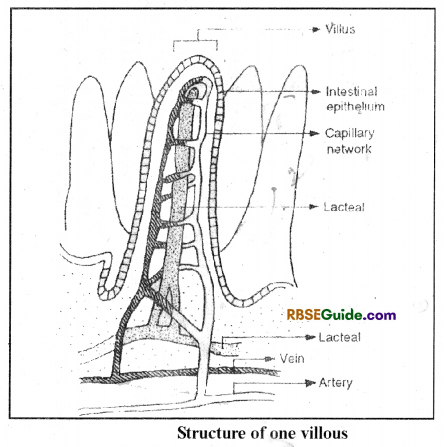
- The anus is controlled by an anal sphinctor which is made p of striated muscles.
- The rectum is without serosa and mesenteries.
Digestive Glands
- The digestive system of man includes 3 type; of digestive glands viz-Salivary glands, Liver and Pancreas.
- These digestive glands are endodermal in origin.
Salivary Glands
- There are three pairs’of salivary glands in human beings viz.-
(i) sublingual
(ii) submaxillary and
(iii) Parotid. - These glands secrete saliva which is an alkaline digestive juice. It contain ptyalin lysozyme mucous. The ptyalin is a digestive enzyme which acts on starch. The lysozyme acts as baceriacidal.
- The pH of human saliva is mostly 7.2.
Liver
- It is the largest gland in the body which is situated in the right anterior of the abdominal cavity.
- It is chocklety brown in colour. It’s, anterior end is convex and posterior end is concave.
- It is the chief metabolic organ of the body.
- It’s weight in human beings is about 1 to 1-1/2 kg.
- In human being, the liver consists of 2 main Lobes viz. right lobe and left lobe which remain separated by a falciform ligament. The right lobe is further differentiated into a right proper lobe, a quadrate lobe and a caudate lobe.
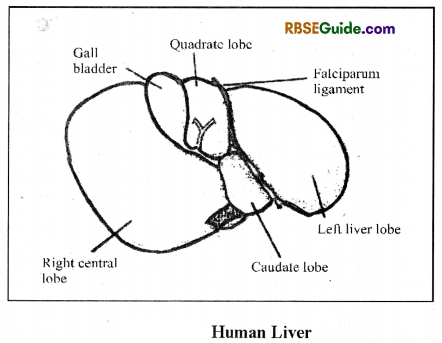
- Hence, there are four lobes in the human liver.
- Bile ducts emerge out from all the lobes which join to form common bile duct or choledocus
- The spigelian lobe is the smallest lobe.
- Right central lobe is the largest lobe.
- The gall bladder is attached to the right central lobe which store the bill juice.
- The hepatic portal vein enters into the Left lateral lobe.
- The liver is bounded by serus capsul which is modified
![]()
Histology of Liver
1. The structural & functional unit of the liver is called as The lobule is polygonal in shape & bounded by Glisson’s capsule.
2. Each lobule has an intra-lobular vein in the centre and many hepatic cords made up of rectangular cells.
3. There are blood filled spaces in between the hepatic cords which are called as, sinusoids.
4. Each comer of the lobule has a portal duct which includes an interlobular vein, liver arteriole, lymph duct & cystic ducts. In sinusoids, the blood flow’s from the intralobular vein into the interlobular veins.
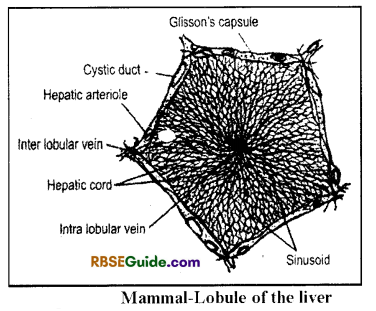
5. There are special Kupffer’s cells which are found a tt ached in the sinusoids on both the sides of the hepatic cords. These cells remove dead RBCS & germs from the blood.
6. The interlobular veins finally join to form two pairs of hepatic veins which lead into the post caval.
Functions of Liver
- It forms bile juice. The bile juice is synthesized in the liver cells constantly. & drops into the bile canaliculi. The bile canaliculi unite to form cystic ducts which finally open into the gall bladder.
- The liver stores vitamines A, D & B12.
- It synthesizes blood clotting factors.
- During embryonic stage, it acts as haemopocitic organ.
- It stores extra food in the form of glycogen.
- It performs detoxification of many toxins.
- It synthesizes many proteins like albumin, fibrinogen, globulin etc.
- It synthesizes urea by ornithine cycle.
- It is the site for glvcogenesis, glvcogenolvsis glyconeogenesis, deamination, lipogenesis
- It synthesizes heparin which is an anti-coagulant.
Pancreas
1. It is an irregular shaped gland which is situated in between the limbs of duodenum.
2. It is considered as second largest gland.
3. It performs both exocrine & endocrine functions simultaneously.
4. The exocrine function is performed by acini. Each acinus has a central duct surrounded by columnar gland cells. These gland cells secrete pancreatic juice. The ductules of the acini unite to form ducts of Santorina which intum unite to form main pancreatic duct or Wirsung’s duct. The endocrine function is performed by islets of Langerhans which consists of 5 types of cells—
- α – cells – They secrete glucagon hormone. They are 15 to 20% of total cells.
- β – cells -They secrete insulin hormone. They are 65-80% of total cells.
- δ – cells -They secrete somatostatin hormone. They are 3-10% of total cells.
- pp – cells -They secrete pancreatic polypeptide. They are 3 to 5% of total cells.
- They secrete ghrelin hormone. They are less than 1%.
Both the acini & the islets of Langerhans remain situated in the connective tissues containing nerves. B. Vs. & lymph ducts.
![]()
Physiology of Digestion
Physiology of digestion can be studied under following heads :
- Ingestion
- Digestion
- Absorption
- Assimilation
- Defaecation
Ingestion
- Taking in of food is called as ingestion.
- Human beings are omnivorous concern to food.
Digestion
- Digestion is a physio-chemical process in which complex and insoluble food material is converted into it’s simple and soluble form.
Digestion in buccal cavity
1. Entry of the food into the buccal cavity results in the secretion of saliva. The pH of saliva in rabbit is 7.2.
2. In human beings, the pH of saliva is 6.8 to 7.2 & about 1/2 to 1 litre of saliva is produced per day.
3. The saliva includes 99.5% water and 0.5% solids. The solids include mucous, ptyalin or salivary amylase, lysozyme & salts.
4. The mucous of the saliva makes the food soft & slimy.
5. The lysozyme acts as germicidal.
![]()
6. The ptyalin or salivary amylase enzyme converts starch (simple polysaccharides) into maltose (disaccharides)
7. There is mastication of the food in the buccal cavity. It involves grinding of the food & mixing of the food with saliva.
8. The secretion of saliva is called as salivation.
9. The digestion in the buccal cavity results in the formation of bolus. The bolus is swallowed with the help of the tongue which is called as deglutition. The degliutition is a voluntary process.
10. The bolus, in the oesophagus moves with the help of peristalsis, an involuntary process.

Digestion in stomach
1. Entry of the bolus into the stomach results in the secretion of a gastrin hormone which acts on the gastric glands to secrete gastric juice.
2. In human beings about 1-1 1/2 litres of the gastric juice is produced per day. It includes 98.5% water & 1.5% solids
(a) HCl is secreted by the oxyntic cells. It is about 0.04% & it makes the medium strongly acidic (pH ⇒ 1 to 2) It performs following functions :
- It acts as a strong germicidal.
- It activates the gastric enzymes and provide liquid . medium for their action.
- It stops the action of the ptyalin enzyme.
- It regulates the pyloric sphinctor.
(b) Prorenin form an active enzyme renin in presence of dilute HCl. The renin in acidic medium converts milk (caesinogen protein) into curd (caesin or calcium paracaesinato). In adults, renin is absent.

(c) Pepsinogen activates & forms pepsin on contact with the dilute HCl. The pepsin converts proteins (Polypeptides) into peptones (dipeptides) & proteoses (tripeptides).
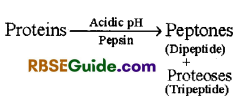
(d) Gastric lipase acts only on the emulcified fats. Natural food contain less than 1% of emulcified fats.
- Hence, very little or no fat digestion takes place in the stomach.
- The stomach also secretes a Castle factor which helps in the absorption of the vitamin B12.
- Digestion in the stomach results in the formation of chyme which enters into the duodenum.
- Digestion in the stomach takes about 3 hours.
Digestion in Duodenum
1. Entry of chyme into the duodenum results in the secretion of bile juice.
2. The bile juice is greenish-yellow digestive juice which is alkaline (pH-7 to 8). It is without any digestive enzyme. In human beings, about 1 litre of the bile juice is produced every day.
3. Chemical composition of the bile-The bile juice includes following substances-
| Water | 89.0% |
| Bile salts (Taurocholate & Glycocholate) |
6.0% |
| Bile pigments (Bilirubin and‘Biliverdin) |
3.5% |
| Inorganic salts | 0.7% |
Functions of the bile juice
- It neutralizes the acidic medium of the chyme.
- The bile salts perform emulcification of the fats.
- It acts as a bacteriacidal.
- The bile salts help in the absorption of the fatty acids.
- It excretes excess of the cholesterol.
- It excretes bile pigments which are formed in the liver by the degradation of the haemoglobin.
- The duodenum also receives the pancreatic juice.
- The pancreatic juice is a colourless & alkaline juice (pH 8). It contains 98.5% water & 1.5% solids. Inhuman beings, Vz to 1 litre of pancreatic juice is secreted per day.
The pancreatic juice has 2 parts-
![]()
(a) Salt part
- It is under the control of secretin hormone.
- It contains chloride, carbonate & bicarbonates of sodium, potassium & calcium.
- It makes the chyme alkaline.
(b) Enzymatic part
1. It is secreted under the control of pancreozyme.
2. It includes following main enzymes :
- Trypsinogen
- Chymotrypsinogen
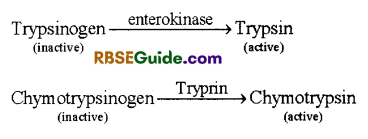
Active trypsin & chymotrypsin covert the proteins completely into peptones & proteoses. The trypsin breaks the peptide bonds formed between the arginine and lysin amino acids. Similarly, the chymotrypsin breaks the peptide bonds formed between the aromatic amino acids.
Pancreatic amylase
- It is also called as amylopsin.
- It converts simple polysaccharides into disaccharides.
Lipase
- It is also called as steapsin.
- It converts emulcified fats into fatty acids & glycerol.
- Digestion in the duodenum results in the formation of chyle which enters into the ileum.
Digestion in Ileum
1. Entry of the chyle into ileum results in the secretion of two hormones viz.—Enterokinin & Villikrinin.
2. The enterokinin acts on the intestinal glands & results in the secretion of intestinal juice or succus entericus.
3. The intestinal juice is an alkaline juice (pH-8). It contains 98.5% water & 1.5% It includes many enzymes such as invertase, maltase, lactase, lipase, aminopeptidase, nuclease, nucleotidase, nucleosidase ,
- Sucrose + Sucrase → Glucose + Fructose
- Maltose + Maltase → Glucose + Glucose
- Lactose + Lactase → Glucose + Galactose
- Emulcified fats + Lipase → Fatty acids + Glycerol
- Peptones + Amino peptidases → Amino acids & Proteoses
- In ileum, there is complete digestion of all substances except the
Absorption of the digested food
1. There is absorption of the digested food in the ileum into the blood with the help of active transport. The villi provide increased surface for the absorption. The villikrinin hormone enchances the absorption by increasing villi movements.
2. There are about 45 lakh of villi in the ileum of human beings.
3. The monosaccharides (glucose, galactose, fructose, man nose etc.) are absorbed directly into the blood by active transport in the presence of water.
4. The amino acids are also absorbed directly into the blood by active transport.
5. Alcohol is absorbed by diffusion in the whole alimentary canal.
![]()
6. The fatty acids before the absorption form an emulsion in presence of bile salts which is called as miscelles. These miscelles are taken up by the epithelial cells with the help of The epithelial cells pack these fatty acids in small packets which are called as chylomicrons. The diameter of the chylomicron is about 1µ. The chylomicrons are released into the lacteals by exocytosis. The chylomicrons from the lymph reach into the blood at the junction between subclavian & jugular veins.
7. The water soluble vitamins are absorbed directly into the blood by diffusion.
8. Absorption of the vitamin B 12 needs the presence of castle factor.
9. Fat soluble vitamins are absorbed with the help of bile salts like the fatty acids absorption.
10. About 20 litre of water can be absorbed in human intestine per day.
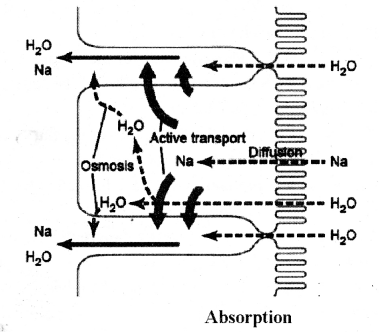
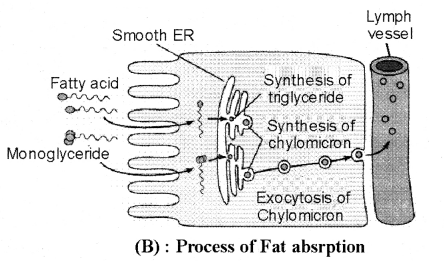
Assimilation and Defaecation
1. The blood transports the digested food which finally reach into the body cells for use. The sue of the digested food is called as assimilation.
2. The amino acids are used to synthesize proteins. The vitamins are used in various vital activities. The glucose and the fats are used as source of energy.
3. There is purification of the substance by bacteria in the colon. The colon also absorbs water and salts, as a result the faecal matter becomes semi-solid.
4. The characteristics smell of the faecal matter is due to presence of skatol, indol and cresol in the stool. They are formed in the colon from the tryptophane amino acid by the action of bacteria.
5. The characteristic colour of the faecal matter is due to stercobilin or urcobilin which are formed in the colon from the bile pigments.
6. The removal of undigested food is called as defaecation of egestion.
7. The egestion is a voluntary process which is controlled by the anal sphinctor.

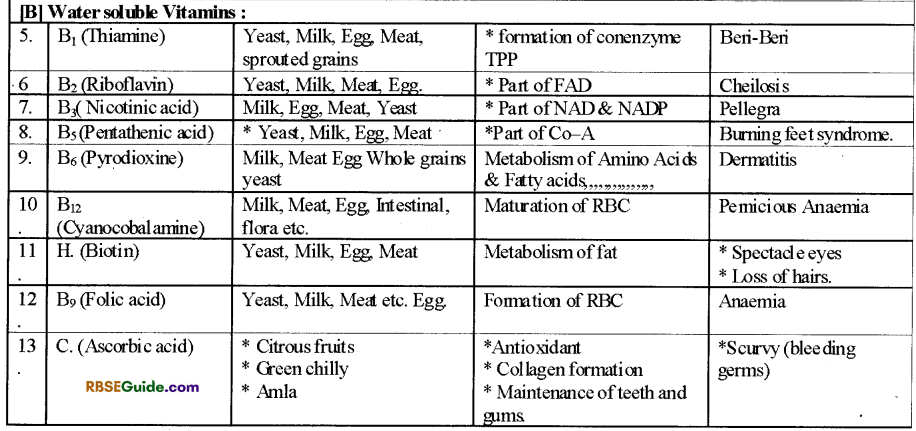
Vitamins
- They are special organic compounds which are not the source of energy. They are required in very small but definite quantity.
- Their account is given in Table 22.2
![]()
Malnutrition and Nutritional disorders
General
- Malnutrition means incomplete nutrition or lack of nutrients. The malnutrition is a diseased state of body which is caused by consuming imbalanced diet or the body is unable to absorb nutrients due to some disease.
Malnutrition is of 4 types
1. Undernutrition : When there is insufficient availability of food for longer time, the condition is called as undernutrition.
2. Overnutrition : When excess of food is consumed for a long period, the condition is called as overnutrition.
3. Imbalanced nutrition: When nutritents in the food (diet) are not in proper ratio i.e. some nutrients are in excess and other nutrients are less than requirement.
4. Specific deficiency : When the diet lacks a specific nutrient completely or in less quantity.
- Malnutrition makes the person weak and may be diseased. About 30 crore of persons are suffering from malnutrition in the world.
- The malnutrition inhibits the physical and mental growth of children.
WHO (World Health Organization)
- Identified five main diseases associated with malnutrition. They are as follows :
- Kwarshiorkar : It occurs in children upto 5 years due to deficiency of proteins.
- Marasmus : It occurs in children upto one year due to deficiency of proteins, fats and carbohydrates.
- Xerophthalamia : It is caused due to deficiency of Vitamin – A.
- Anaemia : It is caused due to deficiency of Iron.
- Simple goitre : It is caused due to deficiency of Iodine.
The other diesases caused due to deficiency of proteins, carbohydrates, fats, mineral or vitamins are as follows :
- PEM (Protein-energy malnutrition)
- Mineral deficiency disease : Osteoporosis
- Vitamin deficiency diseases : Table 2
PEM [Protein-Energy Malnutritino]
- It is also called as protein, calorie malnutrition (RCM). It is caused due to deficiency of proteins, carbohydrates and fats. It occurs in children from one to five years. PEM is of two types : Kwashiorkar and Marasmus.
Reasons of PEM :
- Such disease are seen commonly in undeveloped African countries.
- Mothers stop mother feed (Milk) very early to infants.
- Infants are fed with protein deficient diet.
- In countries where maize is consumed as chief food. The maize lack tryptophane amino acid.
![]()
Kwasiknrkar
- It is a deficiency disease which occurs in children upto 5 years due to deficiency of proteins. Sue children consume less than 1 gm protein per kg. body weight per day.
Symptoms
- Loss of body weight and distaste to food.
- Skin becomes scaly and black.
- Oedema in the body due to water retention and building of belly.
- Hair become scanty, thin and grey.
- It is a deficiency disease whic occurs in children upto one year due to deficiency of proteins, carboydrates and fats.
Symptoms :
- Sharp decrease in body weight (less than 60% of the standard bodyweight).
- Body is reduced to skeleton, wrinkelled skin Suncken eyes etc.
- Thin limbs Ribs visible etc.
- PEM can be corrected by consuming protein rich diet.
Obesity
- It is a disease which is very common in developed countries like Europe, America etc.
- An increase in body weight more than 20% of the standard body weight is called as obesity.
- It is caused due to excess intake of energy rich food.
- Obesity causes many health problems such as hypertension, diabetes heart diseases etc.
